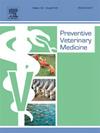抗菌药物敏感性试验的回顾性分析说明了美国东北部猫中耐药葡萄球菌物种的问题
IF 2.4
2区 农林科学
Q1 VETERINARY SCIENCES
引用次数: 0
摘要
葡萄球菌感染由于其人畜共患的潜力、引起一系列疾病的能力和抗菌素耐药性(AMR),在人类和兽医学中都是一个令人关注的问题。本研究回顾性分析了15年来主要来自美国东北部的猫身上分离的1278株葡萄球菌的抗菌素耐药性。优势种为猫科葡萄球菌(26 %)、金黄色葡萄球菌(22 %)和假中间葡萄球菌(15 %)。最常见的分离部位为皮肤和软组织(52% %)和尿道(22% %)。54% %的分离株对至少一种抗菌素耐药。假中间葡萄球菌的总体易感比例最低。总体上对青霉素的敏感性最低(48 %),其次是氨苄西林(49 %)和红霉素(62 %),而对万古霉素和利福平的敏感性最高(≥99 %)。总体多药耐药率为19. %,其中以假中间杆菌菌株最为常见(46. %)。生存模型显示,与2008-2012年相比,2018-2022年几种抗菌素的最低抑制浓度有所增加。与凝固酶阴性葡萄球菌相比,假中间葡萄球菌对β-内酰胺类、氟喹诺酮类、多西环素和甲氧苄啶-磺胺甲恶唑具有更高的mic。猫链球菌的敏感性最高,mic最低。本研究强调了耐多药耐药性和耐多药耐药性在猫科医学和“同一个健康”中的重要性。研究结果强调了在兽医实践中警惕AMR监测和伴侣动物药物抗菌药物管理的必要性。本文章由计算机程序翻译,如有差异,请以英文原文为准。
Retrospective analysis of antimicrobial susceptibility testing illustrates the problem of resistant Staphylococcus species in cats in the northeastern United States
Staphylococcus infections are a concern in both human and veterinary medicine due to their zoonotic potential, ability to cause a spectrum of diseases, and antimicrobial resistance (AMR). This study retrospectively analyzed AMR among 1278 Staphylococcus isolates obtained from cats over 15 years, primarily from the northeastern United States. Staphylococcus felis (26 %), Staphylococcus aureus (22 %), and Staphylococcus pseudintermedius (15 %) were the predominant species. The most common isolation sites were skin and soft tissue (52 %) and urinary tract (22 %). Resistance to at least one antimicrobial was seen in 54 % of isolates. S. pseudintermedius displayed the lowest proportion of susceptibility overall. Susceptibility was lowest overall to penicillin (48 %), followed by ampicillin (49 %) and erythromycin (62 %), while susceptibility was highest to vancomycin and rifampin (≥99 %). The overall prevalence of multidrug resistance was 19 %, most common among S. pseudintermedius isolates (46 %). Survival models revealed increased minimum inhibitory concentrations for several antimicrobials in 2018–2022 compared to 2008–2012. Compared to coagulase-negative staphylococcal species, S. pseudintermedius had higher MICs for β-lactams, fluoroquinolones, doxycycline, and trimethoprim-sulfamethoxazole. S. felis had the highest susceptibilities and lowest MICs. This study underscores the significance of AMR and MDR in feline medicine and One Health. The findings emphasize the need for vigilant AMR surveillance in veterinary practices and antimicrobial stewardship in companion animal medicine.
求助全文
通过发布文献求助,成功后即可免费获取论文全文。
去求助
来源期刊

Preventive veterinary medicine
农林科学-兽医学
CiteScore
5.60
自引率
7.70%
发文量
184
审稿时长
3 months
期刊介绍:
Preventive Veterinary Medicine is one of the leading international resources for scientific reports on animal health programs and preventive veterinary medicine. The journal follows the guidelines for standardizing and strengthening the reporting of biomedical research which are available from the CONSORT, MOOSE, PRISMA, REFLECT, STARD, and STROBE statements. The journal focuses on:
Epidemiology of health events relevant to domestic and wild animals;
Economic impacts of epidemic and endemic animal and zoonotic diseases;
Latest methods and approaches in veterinary epidemiology;
Disease and infection control or eradication measures;
The "One Health" concept and the relationships between veterinary medicine, human health, animal-production systems, and the environment;
Development of new techniques in surveillance systems and diagnosis;
Evaluation and control of diseases in animal populations.
 求助内容:
求助内容: 应助结果提醒方式:
应助结果提醒方式:


